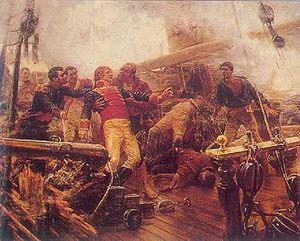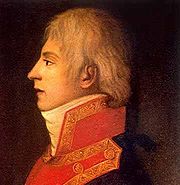
Spanish ship San Juan Nepomuceno
Encyclopedia
San Juan Nepomuceno was a Spanish ship of the line launched in 1765 from the royal shipyard in Guarnizo
(Cantabria
). Like many 18th Century Spanish warships she was named after a saint (John of Nepomuk
). She was a solidly built ship of proven seaworthy qualities.
Her sister-ships were San Pascual, San Francisco de Asis, San Lorenzo, Santo Domingo and San Agustín
.
She was fitted with a total of 74 cannons: 28 24-pounders, 30 18-pounders, 8 12-pounders and 8 8-pounders, and was manned by 8 officers, 11 midshipmen, 19 leading seamen and 492 able seamen (530 total). Her supply capacity was for 60 days victuals and 80 days water.
She rendered numerous important services to the Armada (fleet), some of them in the Caribbean where she participated in several sieges and was distinguished in 1779.
In 1793, she took part in the Anglo-Spanish occupation of Toulon under the command of Admiral Don Juan de Lángara
. Four years later, in 1797, she was part of a Spanish fleet under Teniente General José de Córdoba that fought against the British at the Battle of Cape St. Vincent
.
 The Battle of Trafalgar
The Battle of Trafalgar
is the historical feat in which she participated and of which we have the best account. In spite of being dismasted by Admiral Nelson's artillery on the 21st October 1805, she achieved glory in this battle under the command of the famous Brigadier Don Cosme Damian Churruca
and constituted for the Spaniards a handsome example of the heroism of their nation and the bravery of their sailors.
The San Juan Nepomuceno was one of the last ships still fighting after most of the French ships had surrendered and most of the Spanish ships had either been captured or had yielded. The commander, Don Cosme Churruca, had previously ordered for the flag to be nailed to the highest mast. At the time, it was commonplace for ships to signal surrender by lowering their nation's flag. 'Nailing the flag' was a way to tell the enemy, allies, and indeed the ship's own crew and officers not to expect an easy surrender. As the hours passed, the wounded Admiral Nelson
continued to direct the battle, while the Brigadier Churruca, whose leg had been torn off by a cannon ball, the deck of his ship covered by the blood of his wounded and dead seamen, continued to stubbornly order his ship's batteries to fire. Mortally wounded, the Basque-born Churruca prohibited his officers from surrendering and ordered them to continue returning fire whilst he remained breathing. His officers kept their word, even after Churruca died and command of the ship had been passed to Francisco de Moyna (second-in-command
), who continued the fight until he himself was killed, replaced by the next officer in command who also refused to surrender (he later fell under musket fire and was replaced by yet another officer). However, unable to break the circle of fire formed by the six enemy ships, which counted among others with the famous Defiance
, Tonnant
and Dreadnought
, and in order to prevent the ship from sinking with all the wounded trapped below, the last officer left alive on the San Juan Nepomuceno yielded with over 400 dead and injured on board. The British obtained a brilliant victory but paid a high price in lives.
 After Trafalgar, the ship was taken into British service as HMS San Juan and served as a supply hulk
After Trafalgar, the ship was taken into British service as HMS San Juan and served as a supply hulk
for many years at Gibraltar
. In honour of Churruca's courage, the cabin he had occupied while alive bore his name on a brass plate, and all who entered it were required to remove their hats as a mark of respect for a gallant enemy.
El Astillero
El Astillero is a town and municipality in the province and autonomous community of Cantabria, northern Spain. It is near the province capital, Santander, and it is known for its shipyard, and for holding the title of Spain Rowing Championships...
(Cantabria
Cantabria
Cantabria is a Spanish historical region and autonomous community with Santander as its capital city. It is bordered on the east by the Basque Autonomous Community , on the south by Castile and León , on the west by the Principality of Asturias, and on the north by the Cantabrian Sea.Cantabria...
). Like many 18th Century Spanish warships she was named after a saint (John of Nepomuk
John of Nepomuk
John of Nepomuk is a national saint of the Czech Republic, who was drowned in the Vltava river at the behest of Wenceslaus, King of the Romans and King of Bohemia. Later accounts state that he was the confessor of the queen of Bohemia and refused to divulge the secrets of the confessional...
). She was a solidly built ship of proven seaworthy qualities.
Her sister-ships were San Pascual, San Francisco de Asis, San Lorenzo, Santo Domingo and San Agustín
Spanish ship San Agustín
The San Agustín was a 74-gun ship of the line built at the royal shipyard in Guarnizo and launched in 1768.She was captured by Portugal in 1776, but returned the following year....
.
She was fitted with a total of 74 cannons: 28 24-pounders, 30 18-pounders, 8 12-pounders and 8 8-pounders, and was manned by 8 officers, 11 midshipmen, 19 leading seamen and 492 able seamen (530 total). Her supply capacity was for 60 days victuals and 80 days water.
She rendered numerous important services to the Armada (fleet), some of them in the Caribbean where she participated in several sieges and was distinguished in 1779.
In 1793, she took part in the Anglo-Spanish occupation of Toulon under the command of Admiral Don Juan de Lángara
Juan de Lángara
Juan Francisco de Lángara y Huarte was a Spanish naval officer and Minister of Marine.-Life and career:He was born at Coruña, Galicia, the son of a renowned Basque family...
. Four years later, in 1797, she was part of a Spanish fleet under Teniente General José de Córdoba that fought against the British at the Battle of Cape St. Vincent
Battle of Cape St. Vincent (1797)
In the Battle of Cape St Vincent a British fleet under Admiral Sir John Jervis defeated a larger Spanish fleet under Admiral Don José de Córdoba near Cape St. Vincent, Portugal.-Origins:...
.

Battle of Trafalgar
The Battle of Trafalgar was a sea battle fought between the British Royal Navy and the combined fleets of the French Navy and Spanish Navy, during the War of the Third Coalition of the Napoleonic Wars ....
is the historical feat in which she participated and of which we have the best account. In spite of being dismasted by Admiral Nelson's artillery on the 21st October 1805, she achieved glory in this battle under the command of the famous Brigadier Don Cosme Damian Churruca
Cosme Damián de Churruca y Elorza
Cosme Damián de Churruca y Elorza was a Basque Spanish noble, an Admiral of the Royal Spanish Armada, a scientist and Major of Mutriku, who died at the Battle of Trafalgar while commanding the ship of the line San Juan Nepomuceno.He received his early years education in the Seminary of Burgos...
and constituted for the Spaniards a handsome example of the heroism of their nation and the bravery of their sailors.
The San Juan Nepomuceno was one of the last ships still fighting after most of the French ships had surrendered and most of the Spanish ships had either been captured or had yielded. The commander, Don Cosme Churruca, had previously ordered for the flag to be nailed to the highest mast. At the time, it was commonplace for ships to signal surrender by lowering their nation's flag. 'Nailing the flag' was a way to tell the enemy, allies, and indeed the ship's own crew and officers not to expect an easy surrender. As the hours passed, the wounded Admiral Nelson
Nelson
- People :* Horatio Nelson, 1st Viscount Nelson, English admiral* Nelson , for other people with the surname "Nelson"* Nelson , for people with the given name "Nelson"...
continued to direct the battle, while the Brigadier Churruca, whose leg had been torn off by a cannon ball, the deck of his ship covered by the blood of his wounded and dead seamen, continued to stubbornly order his ship's batteries to fire. Mortally wounded, the Basque-born Churruca prohibited his officers from surrendering and ordered them to continue returning fire whilst he remained breathing. His officers kept their word, even after Churruca died and command of the ship had been passed to Francisco de Moyna (second-in-command
Second-in-command
The Second-in-Command is the deputy commander of any British Army or Royal Marines unit, from battalion or regiment downwards. He or she is thus the equivalent of an Executive Officer in the United States Army...
), who continued the fight until he himself was killed, replaced by the next officer in command who also refused to surrender (he later fell under musket fire and was replaced by yet another officer). However, unable to break the circle of fire formed by the six enemy ships, which counted among others with the famous Defiance
HMS Defiance (1783)
HMS Defiance was a 74-gun third rate ship of the line of the Royal Navy, built by Randall and Co., at Rotherhithe on the River Thames, and launched on 10 December 1783.-History:...
, Tonnant
HMS Tonnant (1792)
Tonnant was an 80-gun ship of the line of the French Navy and lead ship of the Tonnant class. Admiral Nelson captured her at Aboukir Bay on 1 August 1798. The Royal Navy then took her into service...
and Dreadnought
HMS Dreadnought (1801)
HMS Dreadnought was a Royal Navy 98-gun second rate. This ship of the line was launched at Portsmouth at midday on Saturday, 13 June 1801, after she had spent 13 years on the stocks...
, and in order to prevent the ship from sinking with all the wounded trapped below, the last officer left alive on the San Juan Nepomuceno yielded with over 400 dead and injured on board. The British obtained a brilliant victory but paid a high price in lives.

Hulk (ship)
A hulk is a ship that is afloat, but incapable of going to sea. Although sometimes used to describe a ship that has been launched but not completed, the term most often refers to an old ship that has had its rigging or internal equipment removed, retaining only its flotational qualities...
for many years at Gibraltar
Gibraltar
Gibraltar is a British overseas territory located on the southern end of the Iberian Peninsula at the entrance of the Mediterranean. A peninsula with an area of , it has a northern border with Andalusia, Spain. The Rock of Gibraltar is the major landmark of the region...
. In honour of Churruca's courage, the cabin he had occupied while alive bore his name on a brass plate, and all who entered it were required to remove their hats as a mark of respect for a gallant enemy.

